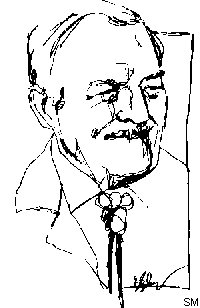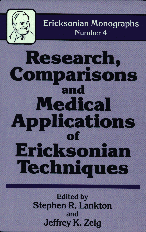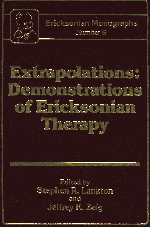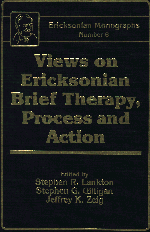Founding Editor 1984-1995 Stephen R. Lankton, L.C.S.W. |
 |
Founding Editor 1984-1995 Stephen R. Lankton, L.C.S.W. |
 |

| The Ericksonian Monographs, Vols. 1-10 contain the highest quality articles on Ericksonian hypnosis and psychotherapy, including technique, theory, and research, during Stephen Lankton’s tenure as Editor-in-Chief. |

| Joseph Barber, Ph.D. | Cloe Madanes |
| Kristina K. Erickson, M.D. | Marion R. Moore, M.D. |
| Richard Fisch, M.D. | Robert E. Pearson, M.D. |
| Stephen G. Gilligan, Ph.D. | Sidney Rosen, M.D. |
| Jay Haley, M.A. | Ernest L. Rossi, Ph.D. |
| Bill O'Hanlon, M.S. | Kay F. Thompson, D.D.S. |
| Carol H. Lankton, M.A. | Jeffrey K. Zeig, Ph.D. |
| Herbert S. Lustig, M.D. |
| Ralph M. Daniel, Ph.D. | Jane A. Parsons, C.S.W. |
| D. Corydon Hammond, Ph.D. | Madeleine Richeport, Ph.D. |
| Ronald A. Havens, Ph.D. | Michele Ritterman, Ph.D. |
| Lynn D. Johnson, Ph.D. | Sandra M. Sylvester, Ph.D. |
| William J. Matthews, Ph.D. | R. Reid Wilson, Ph.D. |
| David M. Northway, M.A. | Michael D. Yapko, Ph.D. |
| Dan C. Overlade, Ph.D. |
| Australia Robert B. McNeilly, M.D. |
Israel Moris Kleinhauz, M.D. Nachman Alon, M.A. |
| Czechoslovakia Michael Vancura, Dipl. Psych |
Italy Camillo Loriedo, M.D. |
| England James Wilk, M.A., M.Sc. |
Japan Gosaku Naruse, Dr.Med.Sci. |
| France Jean Godin, M.D., Ph.D. Jean Lassner, M.D. |
Singapore Chong Tong Mun, B.B.S.B., M.D. |
Germany Burkhard Peter, Dipl.Psych. Hans-Ulrich Schachtner Dipl. Psych. Gunther Schmidt, M.D. Bernhard Trenkle, Dipl.Psych. |
Sweden Bengt Essler, D.D.S. Lars-Eric Unestahl, Ph.D. The Netherlands Kees Hoogduin, M.D. Alfred Lange, Ph.D. |
Number 4:
Research
Comparisons and Medical Applications
|
 |
Number 6: Extrapolation: Demonstrations of Ericksonian Therapy
|
 |
Number 8: Views on Ericksonian Brief Therapy, Process and Action
|
 |
Number 9: The Essence of a Single-Session Success
|
Number 10: Difficult Contexts for Therapy
|
 |
| The Ericksonian Monographs are published by Brunner/Mazel, Inc. (now Brunner-Routledge division of Taylor and Francis), 47 Runway Road, Levittown, PA 19057, 1-800-821-8312 (voice), 215-269-0400 (fax), email: bkorders@tayolorandfrancis.com.. Or, you can visit their homepage at Burnner-Routledge inside: Taylor and Francis. |